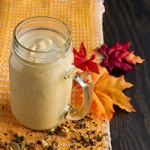I want...
How To Make Sauerkraut
June 27, 2013 By
Leanne Vogel

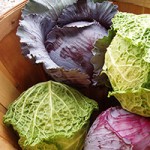 November 29, 2018
November 29, 2018
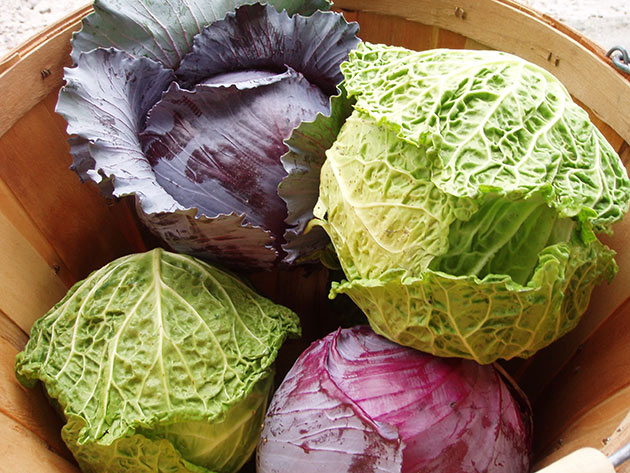
Power posse post by Dana Machacek
Sauerkraut doesn’t exactly have a glamorous reputation.
Keto shopping lists, recipes, and more! Start keto with this FREE 5-step guide.
I'm ready!You may have heard that raw kraut is great for your health. But if you’re anything like me, its health benefits did not come into play in motivating me to go anywhere close to the stuff.
I’ll be honest with you… sauerkraut can be stinky. It can also be intimidating to try at first.
(But!) I’m here to tell you – sauerkraut is totally sexy. You heard me, sexy!
I started out on my personal sauerkraut journey with a great deal of trepidation and some hardened prejudice against the lowly cabbage. Yes, I had decided to make raw kraut at home, but it wasn’t because I wanted to. I confess that I was only making kraut at first because I felt that I ‘should’. So, off I went.
Fast forward a year, and I now enjoy a full cup of raw kraut every single day. Our cupboards and fridge are filled with jars of kraut in various stages of fermentation, and I even bring smaller jars of it along with me.
What changed? How did I go from wrinkling my nose at sauerkraut to devouring it daily without a care in the world?
Simply put: I experienced the nirvana known as “better digestion”. Like, much better digestion.
Get your digestion feelin’ sexy with a batch of homemade sauerkraut – via @be_healthful
Those nutrition experts are on to something, believe me. Raw sauerkraut is packed with good bacteria and enzymes that help to crowd out the less desirable flora in your gut and get your digestion moving. It even works for people with notoriously sluggish digestion, and (honesty time!) anything that can combat uncomfortable bloating, gas, abdominal pain, and indigestion for literally pennies a day is sexiness incarnate.
The best thing about raw kraut is that it is incredibly easy and inexpensive to make at home. Try my recipe below and start incorporating kraut into your daily diet. I promise that you will notice amazing benefits!
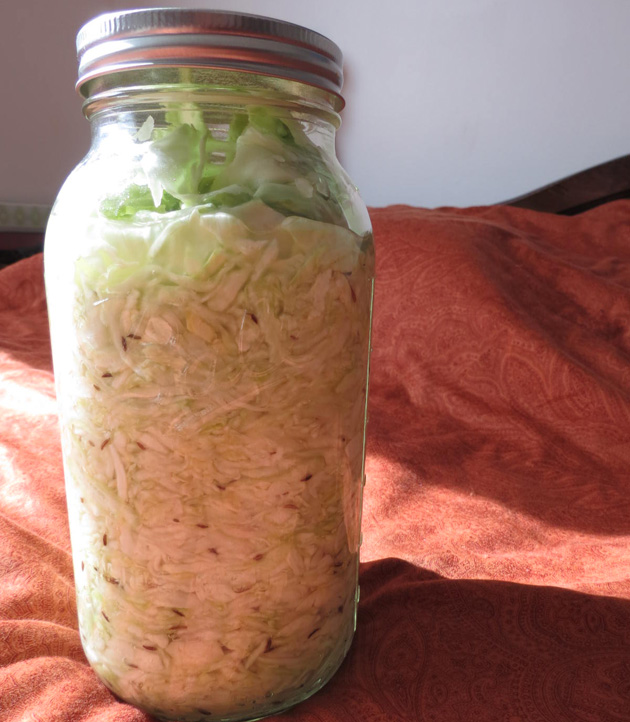
- Sterilized mason jars with tight-fitting lids
- Wooden spoon
- Large green cabbage (organic)
- 1-2 teaspoon high-quality sea salt or celtic salt
- 1 teaspoon caraway seeds (or to taste)
- ½ cup filtered water
- Remove outside leaves of the cabbage (approx. 5 leaves) and set aside for later.
- Chop the rest of cabbage into thin ribbons and place into a large mixing bowl.
- Add salt and caraway seeds to the bowl, using your hands to coat cabbage well.
- Once kraut mixture has been coated, start stuffing bits of it into your mason jar. Add a small layer of kraut to the jar and then use the wooden spoon to pound the air out of the layer before adding more cabbage. You want to make the mixture as tight and air-free as possible to avoid mould.
- Continue adding kraut mixture to the jar, layer by layer, pounding out excess air throughout, until there is between 1 and 2 inches of free space left near the mouth of the jar.
- Roll outside leaves of the cabbage into tight, burrito-style rolls and stuff on top of the shredded kraut.
- Slowly add filtered water to the jar, until it levels with the shredded kraut mixture (not all the way up to the top of the jar). You will need very little water. A half cup is a generous amount– I usually use ¼ cup water or less.
- Slide the lid onto your mason jar and close it to make an airtight seal.
- Label your jar with the date, and leave it in a dark cupboard to ferment between 4 days (warmer climates) and 4 weeks (cooler climates).
- When kraut is ready to consume, break airtight seal, discard outer cabbage leaves, and fork as much shredded cabbage onto your plate as you desire.
- Store opened jars of kraut in the fridge and consume within 2 months.
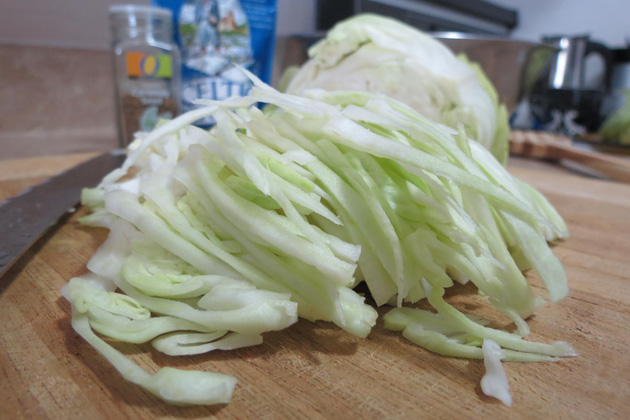
Remove outside leaves of the cabbage (approx. 5 leaves) and set aside for later.
Chop the rest of cabbage into thin ribbons and place into a large mixing bowl.
Add salt and caraway seeds to the bowl, using your hands to coat cabbage well.
Once kraut mixture has been coated, start stuffing bits of it into your mason jar. Add a small layer of kraut to the jar and then use the wooden spoon to pound the air out of the layer before adding more cabbage. You want to make the mixture as tight and air-free as possible to avoid mould.
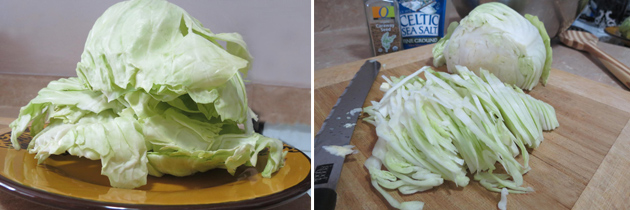
Continue adding kraut mixture to the jar, layer by layer, pounding out excess air throughout, until there is between 1 and 2 inches of free space left near the mouth of the jar.
Roll outside leaves of the cabbage into tight, burrito-style rolls and stuff on top of the shredded kraut.
Slowly add filtered water to the jar, until it levels with the shredded kraut mixture (not all the way up to the top of the jar). You will need very little water. A half cup is a generous amount– I usually use 1/4 cup water or less.
Slide the lid onto your mason jar and close it to make an airtight seal.
Label your jar with the date, and leave it in a dark cupboard to ferment between 4 days (warmer climates) and 4 weeks (cooler climates).
When kraut is ready to consume, break airtight seal, discard outer cabbage leaves, and fork as much shredded cabbage onto your plate as you desire.
Store opened jars of kraut in the fridge and consume within 2 months.
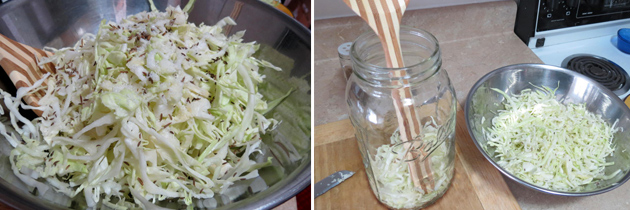
Special Notes:
- Do not use iodized (table) salt or tap water for this recipe. These can disrupt the naturally occurring living cultures inside the cabbage, making your kraut-making adventures a waste of time, ingredients, energy, and money.
- If your kraut develops mould on the top of the jar, the rest of the jar should still be okay to eat. Simply pick off the mouldy bits and enjoy the kraut further down the jar… using your common sense, of course.
- Fermented kraut will taste zesty, a bit salty, and sour like a pickle. It will smell rancid when you open the jar, but it will taste surprisingly delicious. The stink is natural and totally normal.
- Please no boiling of the jar to “seal” it! A normal canning seal (involving heat and/or boiling) will kill off the friendly bacteria and totally defeat the purpose of making the kraut. Everything needs to be room temperature in order for this process to work properly, but yes– it flies in the face of normal canning logic and procedure.
- To get the perfect seal, try these tips: I just slide the lid on top of the jar when I’m going to close it, but I try to slide it sideways onto the mouth of the jar instead of moving it down on top of the jar, to minimize the amount of air that gets trapped in the jar. (It’s a sneak attack closing.) That said, it’s really important to pound out as much air as possible while the kraut is being jarred, which is why I transfer the cabbage in layers and then mash it down with a wooden spoon throughout the process. ‘Real’ seals aren’t required, though. The few times (twice in 2+ years) where I have experienced slight moulding in my kraut, it’s been limited to the top (outer) leaves only and the rest of the jar is fine to consume. It sounds wrong, but it’s true.
Variations:
- Use red cabbage instead
- Add shredded carrots or beets
- Use caraway seeds or not. Try adding dill, fennel seeds, dried sea weeds, shredded ginger root, etc.
How do you promote better digestion in your diet?
Have you tried raw kraut before?
I would love to hear your suggestions and recommendations!

Author bio: Dana Machacek holds a Master’s Degree in Communication Studies and runs a thriving art business with her partner, artist Martin Machacek. She recently uncovered a passion for holistic living and will be pursuing nutrition certification later this year. You can follow her journey towards intuitive, body-based living at www.danamachacek.com
Connect with Dana:
Website: Dana Machecek
Facebook: Dana Machecek
Twitter: Dana Machecek
This entry was tagged: candida, digestion, healthy digestion
You May Also Like...
Hi! I'm Leanne (RHN FBCS)
a Functional Medicine Practitioner, host of the Healthful Pursuit Podcast, and best-selling author of The Keto Diet & Keto for Women. I want to live in a world where every woman has access to knowledge to better her health.



